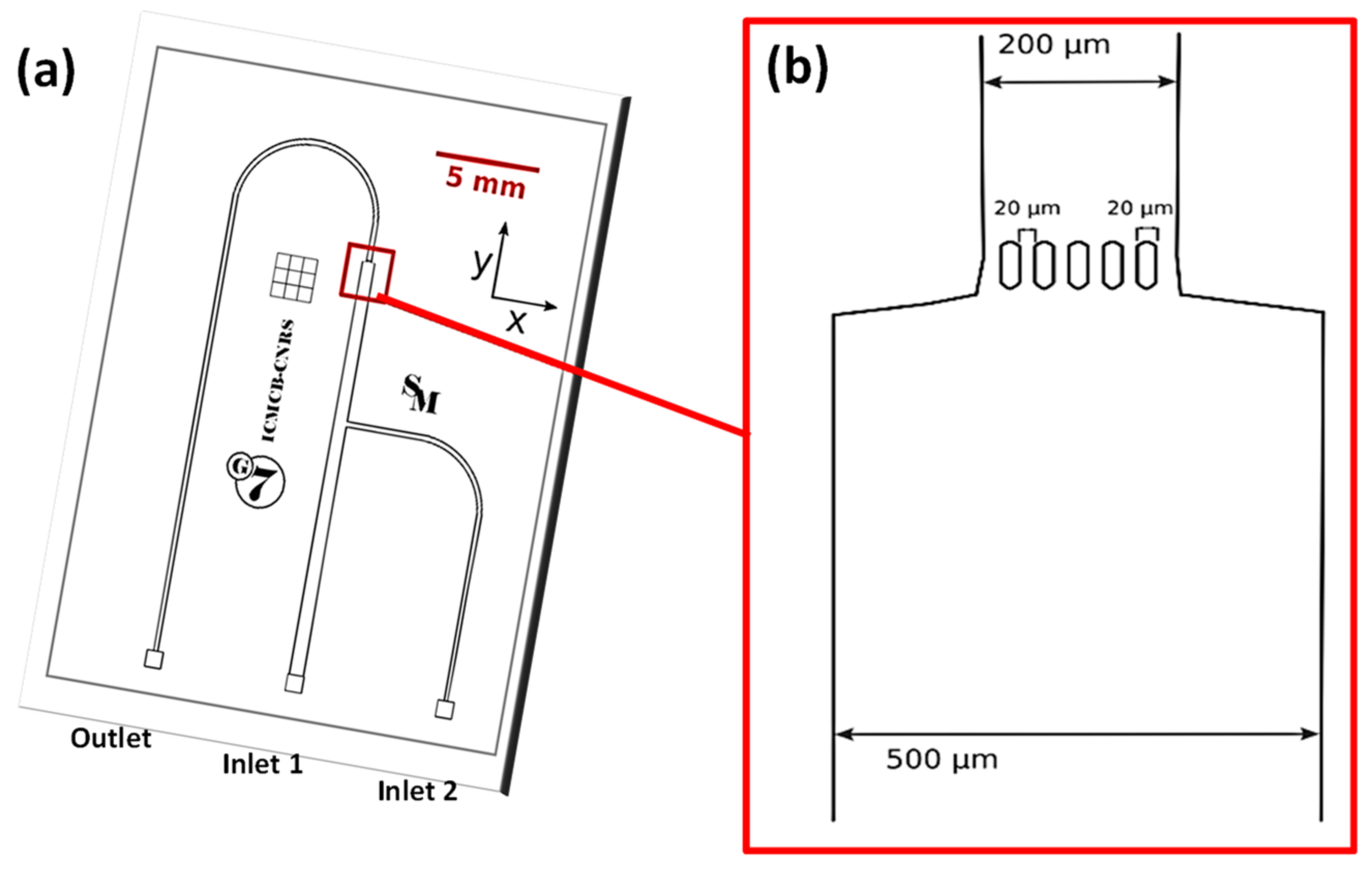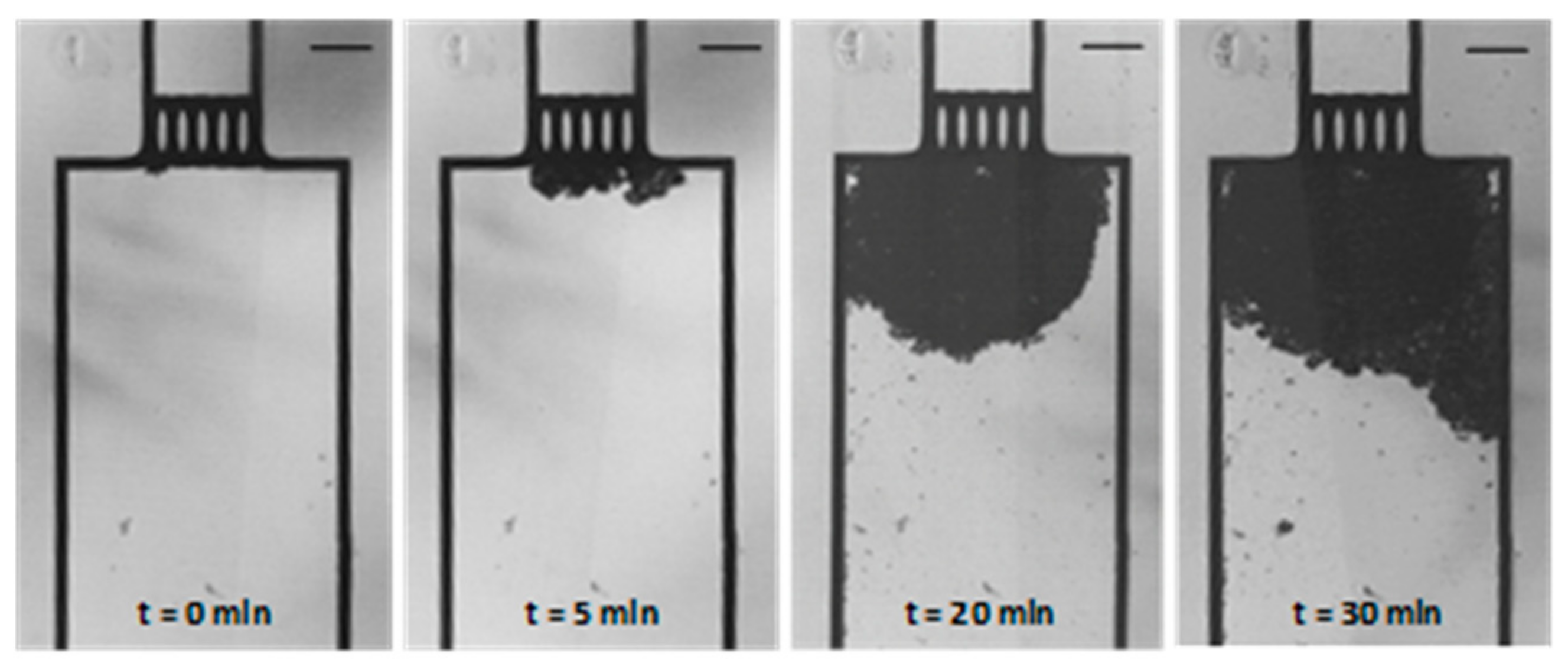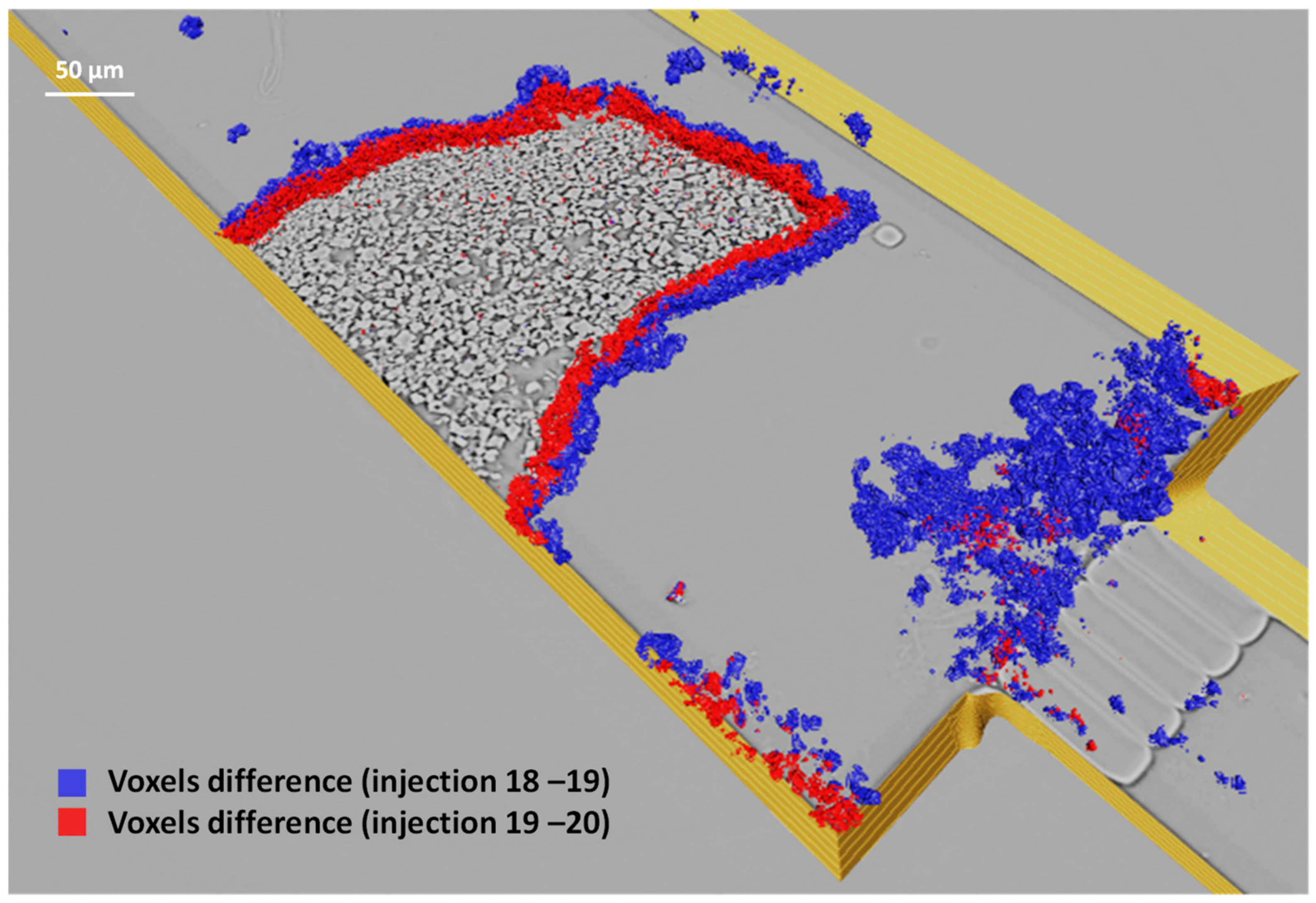3D Imaging of On-Chip Porous Medium Using X-ray Laminography: Application to Reactive Flow Dissolution at Small Scales
Abstract
:1. Introduction
2. Materials and Methods
3. Results and Discussions
3.1. Evolution of the Porous Medium during the Dissolution Process
3.2. Mass Balance Estimation
3.3. Reactive Fluid Flow Pattern
4. Conclusions
Supplementary Materials
Author Contributions
Funding
Data Availability Statement
Acknowledgments
Conflicts of Interest
References
- Dawson, G.K.W.; Pearce, J.K.; Biddle, D.; Golding, S.D. Experimental Mineral Dissolution in Berea Sandstone Reacted with CO2 or SO2–CO2 in NaCl Brine under CO2 Sequestration Conditions. Chem. Geol. 2015, 399, 87–97. [Google Scholar] [CrossRef] [Green Version]
- Falcon-Suarez, I.; Papageorgiou, G.; Chadwick, A.; North, L.; Best, A.I.; Chapman, M. CO2-Brine Flow-through on an Utsira Sand Core Sample: Experimental and Modelling. Implications for the Sleipner Storage Field. Int. J. Greenh. Gas Control 2018, 68, 236–246. [Google Scholar] [CrossRef]
- Huq, F.; Haderlein, S.B.; Cirpka, O.A.; Nowak, M.; Blum, P.; Grathwohl, P. Flow-through Experiments on Water–Rock Interactions in a Sandstone Caused by CO2 Injection at Pressures and Temperatures Mimicking Reservoir Conditions. Appl. Geochem. 2015, 58, 136–146. [Google Scholar] [CrossRef]
- Peng, C.; Crawshaw, J.P.; Maitland, G.C.; Trusler, J.P.M. Kinetics of Calcite Dissolution in CO2-Saturated Water at Temperatures between (323 and 373) K and Pressures up to 13.8 MPa. Chem. Geol. 2015, 403, 74–85. [Google Scholar] [CrossRef] [Green Version]
- Rötting, T.S.; Luquot, L.; Carrera, J.; Casalinuovo, D.J. Changes in Porosity, Permeability, Water Retention Curve and Reactive Surface Area during Carbonate Rock Dissolution. Chem. Geol. 2015, 403, 86–98. [Google Scholar] [CrossRef]
- Al-Khulaifi, Y.; Lin, Q.; Blunt, M.J.; Bijeljic, B. Reservoir-Condition Pore-Scale Imaging of Dolomite Reaction with Supercritical CO2 Acidified Brine: Effect of Pore-Structure on Reaction Rate Using Velocity Distribution Analysis. Int. J. Greenh. Gas Control 2018, 68, 99–111. [Google Scholar] [CrossRef]
- Khather, M.; Saeedi, A.; Rezaee, R.; Noble, R.R.P. Experimental Evaluation of Carbonated Brine-Limestone Interactions under Reservoir Conditions-Emphasis on the Effect of Core Scale Heterogeneities. Int. J. Greenh. Gas Control 2018, 68, 128–145. [Google Scholar] [CrossRef]
- Menke, H.P.; Andrew, M.G.; Blunt, M.J.; Bijeljic, B. Reservoir Condition Imaging of Reactive Transport in Heterogeneous Carbonates Using Fast Synchrotron Tomography—Effect of Initial Pore Structure and Flow Conditions. Chem. Geol. 2016, 428, 15–26. [Google Scholar] [CrossRef] [Green Version]
- Menke, H.P.; Reynolds, C.A.; Andrew, M.G.; Pereira Nunes, J.P.; Bijeljic, B.; Blunt, M.J. 4D Multi-Scale Imaging of Reactive Flow in Carbonates: Assessing the Impact of Heterogeneity on Dissolution Regimes Using Streamlines at Multiple Length Scales. Chem. Geol. 2018, 481, 27–37. [Google Scholar] [CrossRef]
- Pearce, J.K.; Golab, A.; Dawson, G.K.W.; Knuefing, L.; Goodwin, C.; Golding, S.D. Mineralogical Controls on Porosity and Water Chemistry during O2-SO2-CO2 Reaction of CO2 Storage Reservoir and Cap-Rock Core. Appl. Geochem. 2016, 75, 152–168. [Google Scholar] [CrossRef] [Green Version]
- Tutolo, B.M.; Luhmann, A.J.; Kong, X.-Z.; Saar, M.O.; Seyfried, W.E. CO2 Sequestration in Feldspar-Rich Sandstone: Coupled Evolution of Fluid Chemistry, Mineral Reaction Rates, and Hydrogeochemical Properties. Geochim. Et Cosmochim. Acta 2015, 160, 132–154. [Google Scholar] [CrossRef] [Green Version]
- Lenormand, R.; Touboul, E.; Zarcone, C. Numerical Models and Experiments on Immiscible Displacements in Porous Media. J. Fluid Mech. 1988, 189, 165–187. [Google Scholar] [CrossRef]
- Morais, S.; Liu, N.; Diouf, A.; Bernard, D.; Lecoutre, C.; Garrabos, Y.; Marre, S. Monitoring CO2 Invasion Processes at the Pore Scale Using Geological Labs on Chip. Lab A Chip 2016, 16, 3493–3502. [Google Scholar] [CrossRef]
- Marre, S.; Adamo, A.; Basak, S.; Aymonier, C.; Jensen, K.F. Design and Packaging of Microreactors for High Pressure and High Temperature Applications. Ind. Eng. Chem. Res. 2010, 49, 11310–11320. [Google Scholar] [CrossRef]
- Morais, S.; Cario, A.; Liu, N.; Bernard, D.; Lecoutre, C.; Garrabos, Y.; Ranchou-Peyruse, A.; Dupraz, S.; Azaroual, M.; Hartman, R.L.; et al. Studying Key Processes Related to CO2 Underground Storage at the Pore Scale Using High Pressure Micromodels. React. Chem. Eng. 2020, 5, 1156–1185. [Google Scholar] [CrossRef]
- Boyd, V.; Yoon, H.; Zhang, C.; Oostrom, M.; Hess, N.; Fouke, B.; Valocchi, A.J.; Werth, C.J. Influence of Mg2+ on CaCO3 Precipitation during Subsurface Reactive Transport in a Homogeneous Silicon-Etched Pore Network. Geochim. Et Cosmochim. Acta 2014, 135, 321–335. [Google Scholar] [CrossRef]
- Harrison, A.L.; Dipple, G.M.; Song, W.; Power, I.M.; Mayer, K.U.; Beinlich, A.; Sinton, D. Changes in Mineral Reactivity Driven by Pore Fluid Mobility in Partially Wetted Porous Media. Chem. Geol. 2017, 463, 1–11. [Google Scholar] [CrossRef]
- Katz, G.E.; Berkowitz, B.; Guadagnini, A.; Saaltink, M.W. Experimental and Modeling Investigation of Multicomponent Reactive Transport in Porous Media. J. Contam. Hydrol. 2011, 120–121, 27–44. [Google Scholar] [CrossRef] [PubMed]
- Tartakovsky, A.M.; Redden, G.; Lichtner, P.C.; Scheibe, T.D.; Meakin, P. Mixing-Induced Precipitation: Experimental Study and Multiscale Numerical Analysis. Water Resour. Res. 2008, 44, W06S04. [Google Scholar] [CrossRef]
- Zhang, C.; Dehoff, K.; Hess, N.; Oostrom, M.; Wietsma, T.W.; Valocchi, A.J.; Fouke, B.W.; Werth, C.J. Pore-Scale Study of Transverse Mixing Induced CaCO3 Precipitation and Permeability Reduction in a Model Subsurface Sedimentary System. Environ. Sci. Technol. 2010, 44, 7833–7838. [Google Scholar] [CrossRef]
- Jaho, S.; Athanasakou, G.D.; Sygouni, V.; Lioliou, M.G.; Koutsoukos, P.G.; Paraskeva, C.A. Experimental Investigation of Calcium Carbonate Precipitation and Crystal Growth in One- and Two-Dimensional Porous Media. Cryst. Growth Des. 2016, 16, 359–370. [Google Scholar] [CrossRef]
- Kim, M.; Sell, A.; Sinton, D. Aquifer-on-a-Chip: Understanding Pore-Scale Salt Precipitation Dynamics during CO2 Sequestration. Lab A Chip 2013, 13, 2508–2518. [Google Scholar] [CrossRef] [PubMed]
- Song, W.; de Haas, T.W.; Fadaei, H.; Sinton, D. Chip-off-the-Old-Rock: The Study of Reservoir-Relevant Geological Processes with Real-Rock Micromodels. Lab A Chip 2014, 14, 4382–4390. [Google Scholar] [CrossRef]
- Karambeigi, M.S.; Schaffie, M.; Fazaelipoor, M.H. Improvement of Water Flooding Efficiency Using Mixed Culture of Microorganisms in Heterogeneous Micro-Models. Pet. Sci. Technol. 2013, 31, 923–931. [Google Scholar] [CrossRef]
- Liu, N.; Skauge, T.; Landa-Marbán, D.; Hovland, B.; Thorbjørnsen, B.; Radu, F.A.; Vik, B.F.; Baumann, T.; Bødtker, G. Microfluidic Study of Effects of Flow Velocity and Nutrient Concentration on Biofilm Accumulation and Adhesive Strength in the Flowing and No-Flowing Microchannels. J. Ind. Microbiol. Biotechnol. 2019, 46, 855–868. [Google Scholar] [CrossRef] [PubMed]
- Singh, R.; Yoon, H.; Sanford, R.A.; Katz, L.; Fouke, B.W.; Werth, C.J. Metabolism-Induced CaCO3 Biomineralization During Reactive Transport in a Micromodel: Implications for Porosity Alteration. Environ. Sci. Technol. 2015, 49, 12094–12104. [Google Scholar] [CrossRef] [PubMed]
- Sygouni, V.; Manariotis, I.D.; Chrysikopoulos, C.V. Experimental Investigation of the Effect of Carbon Dioxide on Pseudomonas Putida Biofilms in a Two-Dimensional Glass Network Micromodel. Int. J. Greenh. Gas Control 2016, 46, 240–247. [Google Scholar] [CrossRef]
- Gavoille, T.; Pannacci, N.; Bergeot, G.; Marliere, C.; Marre, S. Microfluidic Approaches for Accessing Thermophysical Properties of Fluid Systems. React. Chem. Eng. 2019, 4, 1721–1739. [Google Scholar] [CrossRef]
- Liu, N.; Aymonier, C.; Lecoutre, C.; Garrabos, Y.; Marre, S. Microfluidic Approach for Studying CO2 Solubility in Water and Brine Using Confocal Raman Spectroscopy. Chem. Phys. Lett. 2012, 551, 139–143. [Google Scholar] [CrossRef]
- Lee, S.G.; Lee, H.; Gupta, A.; Chang, S.; Doyle, P.S. Site-Selective In Situ Grown Calcium Carbonate Micromodels with Tunable Geometry, Porosity, and Wettability. Adv. Funct. Mater. 2016, 26, 4896–4905. [Google Scholar] [CrossRef]
- Song, W.; Kovscek, A.R. Direct Visualization of Pore-Scale Fines Migration and Formation Damage during Low-Salinity Waterflooding. J. Nat. Gas Sci. Eng. 2016, 34, 1276–1283. [Google Scholar] [CrossRef]
- Song, W.; Kovscek, A.R. Functionalization of Micromodels with Kaolinite for Investigation of Low Salinity Oil-Recovery Processes. Lab A Chip 2015, 15, 3314–3325. [Google Scholar] [CrossRef]
- Zhang, Y.Q.; Sanati-Nezhad, A.; Hejazi, S.H. Geo-Material Surface Modification of Microchips Using Layer-by-Layer (LbL) Assembly for Subsurface Energy and Environmental Applications. Lab A Chip 2018, 18, 285–295. [Google Scholar] [CrossRef] [PubMed]
- Porter, M.L.; Jiménez-martínez, J.; Martinez, R.; Mcculloch, Q.; William, J.; Viswanathan, H.S. Lab on a Chip Geo-material microfluidics at reservoir conditions for subsurface energy resource applications. Lab A Chip 2015, 15, 4044–4053. [Google Scholar] [CrossRef] [PubMed]
- Singh, R.; Sivaguru, M.; Fried, G.A.; Fouke, B.W.; Sanford, R.A.; Carrera, M.; Werth, C.J. Real Rock-Microfluidic Flow Cell: A Test Bed for Real-Time in Situ Analysis of Flow, Transport, and Reaction in a Subsurface Reactive Transport Environment. J. Contam. Hydrol. 2017, 204, 28–39. [Google Scholar] [CrossRef] [PubMed]
- Bowden, S.A.; Tanino, Y.; Akamairo, B.; Christensen, M. Recreating Mineralogical Petrographic Heterogeneity within Microfluidic Chips: Assembly, Examples, and Applications. Lab A Chip 2016, 16, 4677–4681. [Google Scholar] [CrossRef] [Green Version]
- Hu, C.; Morris, J.E.; Hartman, R.L. Microfluidic Investigation of the Deposition of Asphaltenes in Porous Media. Lab A Chip 2014, 14, 2014–2022. [Google Scholar] [CrossRef]
- Tanino, Y.; Zacarias-Hernandez, X.; Christensen, M. Oil/Water Displacement in Microfluidic Packed Beds under Weakly Water-Wetting Conditions: Competition between Precursor Film Flow and Piston-like Displacement. Exp. Fluids 2018, 59, 35. [Google Scholar] [CrossRef] [Green Version]
- Soulaine, C.; Roman, S.; Kovscek, A.; Tchelepi, H.A. Pore-Scale Modelling of Multiphase Reactive Flow: Application to Mineral Dissolution with Production of CO2. J. Fluid Mech. 2018, 855, 616–645. [Google Scholar] [CrossRef]
- Renard, F.; Bernard, D.; Desrues, J.; Ougier-Simonin, A. 3D Imaging of Fracture Propagation Using Synchrotron X-Ray Microtomography. Earth Planet. Sci. Lett. 2009, 286, 285–291. [Google Scholar] [CrossRef]
- Renard, F.; Bernard, D.; Thibault, X.; Boller, E. Synchrotron 3D Microtomography of Halite Aggregates during Experimental Pressure Solution Creep and Evolution of the Permeability. Geophys. Res. Lett. 2004, 31, L07607. [Google Scholar] [CrossRef] [Green Version]
- Bernard, D. 3D Quantification of Pore Scale Geometrical Changes Using Synchrotron Computed. Oil Gas Sci. Technol.-Rev. IFP 2005, 60, 747–762. [Google Scholar] [CrossRef]
- Noiriel, C.; Bernard, D.; Gouze, P.; Thibault, X. Hydraulic Properties and Microgeometry Evolution Accompanying Limestone Dissolution by Acidic Water. Oil Gas Sci. Technol.-Rev. IFP 2005, 60, 177–192. [Google Scholar] [CrossRef]
- Noiriel, C.; Steefel, C.I.; Yang, L.; Bernard, D. Effects of Pore-Scale Precipitation on Permeability and Flow. Adv. Water Resour. 2016, 95, 125–137. [Google Scholar] [CrossRef] [Green Version]
- Noiriel, C.; Gouze, P.; Bernard, D. Investigation of Porosity and Permeability Effects from Microstructure Changes during Limestone Dissolution. Geophys. Res. Lett. 2004, 31, L24603. [Google Scholar] [CrossRef]
- Helfen, L.; Baumbach, T.; Mikulík, P.; Kiel, D.; Pernot, P.; Cloetens, P.; Baruchel, J. High-Resolution Three-Dimensional Imaging of Flat Objects by Synchrotron-Radiation Computed Laminography. Appl. Phys. Lett. 2005, 86, 071915. [Google Scholar] [CrossRef]
- Zhou, J.; Maisl, M.; Reiter, H.; Arnold, W. Computed Laminography for Materials Testing. Appl. Phys. Lett. 1996, 68, 3500–3502. [Google Scholar] [CrossRef]
- Helfen, L.; Xu, F.; Suhonen, H.; Urbanelli, L.; Cloetens, P.; Baumbach, T. Nano-Laminography for Three-Dimensional High-Resolution Imaging of Flat Specimens. J. Instrum. 2013, 8, C05006. [Google Scholar] [CrossRef] [Green Version]
- Fisher, S.L.; Holmes, D.J.; Jørgensen, J.S.; Gajjar, P.; Behnsen, J.; Lionheart, W.R.B.; Withers, P.J. Laminography in the Lab: Imaging Planar Objects Using a Conventional x-Ray CT Scanner. Meas. Sci. Technol. 2019, 30, 035401. [Google Scholar] [CrossRef]
- Beuvier, T.; Panduro, E.A.C.; Kwaśniewski, P.; Marre, S.; Lecoutre, C.; Garrabos, Y.; Aymonier, C.; Calvignac, B.; Gibaud, A. Implementation of in Situ SAXS/WAXS Characterization into Silicon/Glass Microreactors. Lab A Chip 2015, 15, 2002–2008. [Google Scholar] [CrossRef]
- Sjöberg, E.L. A Fundamental Equation for Calcite Dissolution Kinetics. Geochim. Cosmochim. Acta 1976, 40, 441–447. [Google Scholar] [CrossRef]
- Tardy, Y.; Al-Droubi, A.; Fritz, B.; Grondin, J.-L. Calcul Des Équilibres Dans Le Système CaCO3-H2O-CO2. Rappel Des Conditions de Dissolution et de Précipitation de La Calcite. Sci. Géologiques Bull. Et Mémoires 1978, 31, 195–202. [Google Scholar]
- Flukiger, F.; Bernard, D. A New Numerical Model for Pore Scale Dissolution of Calcite Due to CO2 Saturated Water Flow in 3D Realistic Geometry: Principles and First Results. Chem. Geol. 2009, 265, 171–180. [Google Scholar] [CrossRef]
- Marre, S.; Lecoutre, C.; Garrabos, Y.; Fauveau, C.; Cario, A.; Nguyen, O. Sapphire Microreactors. International Patent No WO 2021/2051 15 A1, 2023. [Google Scholar]
- You, J.; Lee, K.J. A Pore–Scale Investigation of Surface Roughness on the Evolution of Natural Fractures during Acid Dissolution Using DBS Method. J. Pet. Sci. Eng. 2021, 204, 108728. [Google Scholar] [CrossRef]
- Matter, J.M.; Stute, M.; Snæbjörnsdottir, S.Ó.; Oelkers, E.H.; Gislason, S.R.; Aradottir, E.S.; Sigfusson, B.; Gunnarsson, I.; Sigurdardottir, H.; Gunnlaugsson, E.; et al. Rapid Carbon Mineralization for Permanent Disposal of Anthropogenic Carbon Dioxide Emissions. Science 2016, 352, 1312–1314. [Google Scholar] [CrossRef] [PubMed] [Green Version]
- Sedimentation velocity and potential in a dilute suspension of charged spherical colloidal particles. J. Chem. Soc. Faraday Trans. 2 Mol. Chem. Phys. 1984, 80, 1299–1317.








Disclaimer/Publisher’s Note: The statements, opinions and data contained in all publications are solely those of the individual author(s) and contributor(s) and not of MDPI and/or the editor(s). MDPI and/or the editor(s) disclaim responsibility for any injury to people or property resulting from any ideas, methods, instructions or products referred to in the content. |
© 2023 by the authors. Licensee MDPI, Basel, Switzerland. This article is an open access article distributed under the terms and conditions of the Creative Commons Attribution (CC BY) license (https://creativecommons.org/licenses/by/4.0/).
Share and Cite
Morais, S.; Lecoutre, C.; Philippot, G.; Aubert, G.; Nguyen, O.; Cario, A.; Vidal, E.; Campbell, Z.S.; Garrabos, Y.; Azaroual, M.; et al. 3D Imaging of On-Chip Porous Medium Using X-ray Laminography: Application to Reactive Flow Dissolution at Small Scales. Processes 2023, 11, 1981. https://doi.org/10.3390/pr11071981
Morais S, Lecoutre C, Philippot G, Aubert G, Nguyen O, Cario A, Vidal E, Campbell ZS, Garrabos Y, Azaroual M, et al. 3D Imaging of On-Chip Porous Medium Using X-ray Laminography: Application to Reactive Flow Dissolution at Small Scales. Processes. 2023; 11(7):1981. https://doi.org/10.3390/pr11071981
Chicago/Turabian StyleMorais, Sandy, Carole Lecoutre, Gilles Philippot, Guillaume Aubert, Olivier Nguyen, Anaïs Cario, Emeline Vidal, Zachary S. Campbell, Yves Garrabos, Mohamed Azaroual, and et al. 2023. "3D Imaging of On-Chip Porous Medium Using X-ray Laminography: Application to Reactive Flow Dissolution at Small Scales" Processes 11, no. 7: 1981. https://doi.org/10.3390/pr11071981




